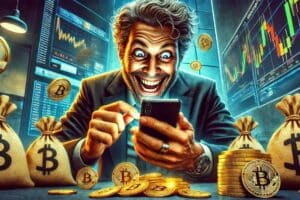For some days now, the Bitcoin fear&greed index, which measures the levels of fear and greed, has been at very high levels.
However, what increased this level was not the election of Donald Trump.
The causes of the high greed level on Bitcoin
The presidential elections in the USA were held on Tuesday, November 5, 2024, and the day after, Wednesday the 6th, the news of Donald Trump’s victory was released.
A month ago, on October 12th, the level of the fear&greed index of the crypto markets was at 49, which is in an absolutely neutral zone.
It should be remembered that this index, which measures the levels of fear or greed perceived in the crypto markets, can only oscillate between zero and one hundred, where zero is absolute fear, and one hundred is absolute greed. Therefore, at the 50 mark, the level is neutral.
However, already on October 15, the level rose to 65, which is in the moderate greed zone.
The fact is that on October 14, the price of Bitcoin had started to rise, going from $63,000 to $66,000.
The fear&greed index measures the levels of the previous day, so the rise to 65 on Tuesday, October 15, actually referred to what had happened in the bull and bear crypto markets on the 14th.
Since then it has risen again, but what matters is the fact that this dynamic anticipated Trump’s election by about three weeks. At this point, it makes one think that the main cause of the high level of greed in the crypto markets since mid-October was the hypothesis of a Trump victory.
The trend in the last few weeks
In fact, at the end of October, and just before the elections, when news spread of a possible recovery by the challenger Kamala Harris, the fear&greed index dropped to 70 points after being at 77 just before the end of October.
At that moment, the price of Bitcoin fell from $72,000 to $67,000, canceling out much of the gains from the previous week.
With Trump’s victory, the level of the fear&greed index returned to 77, and for some days now it has been hovering around that figure.
The reason is obviously the rise in the price of Bitcoin, which with Trump’s victory first went from $68,000 to $75,000, and then continued to rise above $82,000.
What does a high level of greed mean for Bitcoin?
The fear&greed index is not particularly important, also because it measures the performance of the crypto markets from the previous day (that is, it arrives with a day’s delay). But it has its utility.
The fact is that measuring market sentiment brings to light the expectations of retail, although these are only perceived expectations, and one day late.
Retail investors are generally those who buy driven by greed after prices have risen, and who sell driven by fear after they have fallen. In other words, they are those who often lose with the infamous “buy high, sell low”.
Therefore, at this moment, the sentiment in the crypto markets is one of greed, which is driving many retail investors to buy at high prices. Most likely, however, the whales have accumulated at much lower prices in the past months.
Situations like this, also supported by a daily RSI index on the price of Bitcoin that has been in the overbought zone for several days, suggest that a mini-bubble is inflating that should burst sooner or later.
The mini-bubble hypothesis
Regarding the mini-bubbles of Bitcoin, a couple of important premises must be reported.
The first is that mini-bubbles often form, and they only impact the medium/short-term trend. They have nothing to do with the large speculative bubbles that generally last a year, and are often followed by a year of bear-market.
The fact that they impact only in the medium/short term means that mini-bubbles are not at all dangerous in the medium/long term.
The second premise is that when a mini-bubble inflates, the price growth can last for days, or sometimes even weeks, and when it deflates, it is not necessarily the case that the price ends up falling to levels lower than the starting ones. In fact, several times in the past, such mini-cycles have ended with a final price still higher than the initial one.
Now the key point is: at what price levels will the current mini-bubble burst, in case it is indeed a mini-bubble?
If it were to burst now, above $82,000, the price of Bitcoin could also return below $70,000, but if it were to continue to inflate up to $90,000 or $100,000, the final price could be even higher than the current one.
Note that between February and March the fear&greed index remained above 70 points almost continuously for two months, while in this phase it has been above 65 points for less than a month. So in theory, it is not at all certain that the mini-bubble has to deflate already now.


